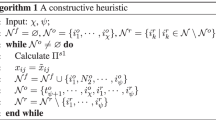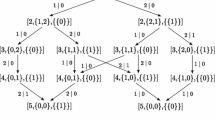Abstract
The car sequencing problem consists of sequencing a given set of cars to be produced in each day. This paper presents an application of the extended coincident algorithm (COIN-E), which is an instance of the estimation of distribution algorithms, to a multi-objective car sequencing problem on a more realistic platform, i.e. two-sided assembly lines. Three conflicting objectives are optimised simultaneously in a Pareto sense including minimise the number of paint colour changes, minimise the total number of ratio constraint violations and minimise the utility work. The performances of COIN-E are compared with COIN (its original version), NSGA II, DPSO and BBO. The results reveal that COIN-E is superior to the other contestant algorithms in both solution quality and diversity.




Similar content being viewed by others
References
Bartholdi, J. J. (1993). Balancing two-sided assembly lines: A case study. International Journal of Production Research, 31(10), 2447–2461.
Boysen, N., Fliedner, M., & Scholl, A. (2009). Sequencing mixed-model assembly lines: Survey, classification, and model critique. European Journal of Operational Research, 192(2), 349–373.
Briant, O., Naddef, D., & Mounié, G. (2008). Greedy approach and multi-criteria simulated annealing for the car sequencing problem. European Journal of Operational Research, 191, 993–1003.
Chutima, P., & Chimklai, P. (2012). Multi-objective two-sided mixed-model assembly line balancing using particle swarm optimisation with negative knowledge. Computers and Industrial Engineering, 62(1), 39–55.
Chutima, P., & Kampirom, N. (2010). A multi-objective coincidence memetic algorithm for a mixed-model U-line sequencing problem. International Journal of Advanced Operations Management, 2(3–4), 201–247.
Chutima, P., & Jitmetta, K. (2013). Adaptive biogeography-based optimisation for two-sided assembly line sequencing problems. International Journal of Operational Research, 16(4), 390–420.
Coello Coello, C. A. (2006). 20 years of evolutionary multi-objective optimization: what has been done and what remains to be done. In G. Y. Yen & D. B. Fogel (Eds.), Computational intelligence: Principles and practice (pp. 73–88). IEEE Computational Intelligence Society.
Cordeau, J. F., Laporte, G., & Pasin, F. (2008). Iterated tabu search for the car sequencing problem. European Journal of Operational Research, 191, 945–956.
Deb, K., Pratap, A., Agarwal, S., & Meyarivan, T. (2002). A fast and elitist multiobjective genetic algorithm: NSGA II. IEEE Transactions on Evolutionary Computation, 6, 182–197.
Estellon, B., Gardi, F., & Nouioua, K. (2008). Two local search approaches for solving real-life car sequencing problems. European Journal of Operational Research, 191, 928–944.
Fliedner, M., & Boysen, N. (2008). Solving the car sequencing problem via branch & bound. European Journal of Operational Research, 191, 1023–1042.
Gagné, C., Gravel, M., & Price, W. L. (2006). Solving real car sequencing problems with ant colony optimization. European Journal of Operational Research, 174, 1427–1448.
Gavranović, H. (2008). Local search and suffix tree for car-sequencing problem with colors. European Journal of Operational Research, 191, 972–980.
Goldberg, D. E. (1989). Genetic algorithm in search, optimization, and machine learning. Reading, MA: Addison-Westley.
Gottlieb, J., Puchta, M., & Solnon, C. (2003). A study of greedy, local search, and ant colony optimization approaches for car sequencing problems. In Proceedings of EvoWorkshops, Lecture notes in computer science (vol. 2611, 246–257). Berlin: Springer.
Horn, J., Nafpliotis, N., & Goldberg, D. E. (1994). A niched Pareto genetic algorithm for multiobjective optimization. In Proceedings of the first IEEE conference on evolutionary computation, IEEE world congress on computational intelligence, Orlando, USA.
Hyun, C. J., Kim, Y., & Kim, Y. K. (1998). A genetic algorithm for multiple objective sequencing problems in mixed model assembly lines. Computers and Operations Research, 25(7–8), 675–690.
Hwang, R. K., & Katayama, H. (2008). A multi-decision genetic approach for workload balancing of mixed-model U-shaped assembly line systems. International Journal of Production Research. doi:10.1080/00207540701851772.
Jaszkiewicz, A., Kominek, P., & Kubiak, M. (2004). Adaptation of the genetic local search algorithm to a car sequencing problem. In Proceedings of 7th national conference on evolutionary algorithms and global Optimization, Poland, pp. 67–74.
Kennedy, J., Eberhart, R. C., & Shi, Y. (2001). Swarm intelligence. San Francisco, CA: Morgan Kaufmann.
Kim, Y. K., Kim, Y., & Kim, Y. J. (2000). Two-sided assembly line balancing: A genetic algorithm approach. Production Planning and Control, 11(1), 44–53.
Kim, Y. K., Song, W. S., & Kim, J. H. (2009). A mathematical model and a genetic algorithm for two-sided assembly line balancing. Computers and Operations Research, 36(3), 853–865.
Kris, T. (2004). On the complexity of the car sequencing problem. Operations Research Letters, 32, 331–335.
Kumar, R., & Singh, P. K. (2007). Pareto evolutionary algorithm hybridized with local search for bi-objective TSP. Studies in Computational Intelligence, 75, 361–398.
Lummus, R. (1995). A simulation analysis of sequencing alternatives for JIT lines using kanbans. Journal of Operations Management, 13, 183–191.
Lee, T. O., Kim, Y., & Kim, Y. K. (2001). Two-sided assembly line balancing to maximize work relatedness and slackness. Computers & Industrial Engineering, 40, 273–292.
Mansouri, S. A. (2005). A multi-objective genetic algorithm for mixed-model sequencing on JIT assembly lines. European Journal of Operational Research, 167(3), 696–716.
McMullen, P. R. (1998). JIT sequencing for mixed model assembly lines with setups in tabu search. Production Planning & Control, 9(5), 504–510.
McMullen, P. R., & Frazier, G. V. (2000). A simulated annealing approach to mixed-model sequencing with multiple objectives on a JIT line. IIE Transactions, 32, 679–686.
McMullen, P. R. (2001). An ant colony optimization approach to addressing a JIT sequencing problem with multiple objectives. Artificial Intelligence in Engineering, 15(3), 309–317.
Miltenburg, J., Steiner, G., & Yeomans, S. (1990). A dynamic programming algorithm for scheduling mixed-model just-in-time production systems. Mathematical Computation Modeling, 13(3), 57–66.
Montgomery, D. C. (2013). Design and analysis of experiments. new york: Wiley.
Nguyen, A., & Cung, V. D. (2005). Le problem du Car Sequencing Renault et le challenge ROADEF 2005. Proceedings of Journées Francophones de Programmation par Contraintes (pp. 3–10).
Özcan, U., & Toklu, B. (2009). Multiple-criteria decision-making in two-sided assembly line balancing: A goal programming and a fuzzy goal programming models. Computers & Operations Research, 36(6), 1955–1965.
Parello, B., Kabat, W., & Wos, L. (1986). Job-shop scheduling using automated reasoning: A case study of the car sequencing problem. Journal of Automated Reasoning, 2(1), 1–42.
Prandtsletter, M., & Raidi, G. R. (2008). An integer linear programming approach and a hybrid variable neighbourhood search for the car sequencing problem. European Journal of Operational Research, 191, 1004–1022.
Puchta, M., & Gottlieb, J. (2002). Solving car sequencing problems by local optimization. Proceedings of EvoWorkshops, Lecture notes in computer science (vol. 2279, pp. 132–142). Berlin: Springer.
Rahimi-Vahed, A. R., Rabbani, M., Tavakkoli-Moghaddam, R., Torabi, S. A., & Jolai, F. (2007). A multi-objective scatter search for a mixed-model assembly line sequencing problem. Advanced Engineering Informatics, 21(1), 85–99.
Rebeiro, C. C., Aloise, D., Noronha, T. F., Rocha, C., & Urrutia, S. (2008a). An efficient implementation of a VNS/ILS heuristic for a real-life car sequencing problem. European Journal of Operational Research, 191, 596–611.
Rebeiro, C. C., Aloise, D., Noronha, T. F., Rocha, C., & Urrutia, S. (2008b). A hybrid heuristic for a multi-objective real-life car sequencing prblems with painting and assembly constraints. European Journal of Operational Research, 191, 981–992.
Simon, D. (2008). Biogeography-based optimization. IEEE Transaction on Evolutionary Computation, 12(6), 702–713.
Smith, K., Palaniswami, M., & Krishnamoorthy, M. (1996). Traditional heuristic versus Hopfield neural network approaches to car sequencing problem. European Journal of Operational Research, 93, 300–316.
Solnon, C., Cung, V. D., Nguyen, A., & Artigues, C. (2008). The car sequeincing problem: Overview of state-of-the-art methods and industrial case-study of the ROADEF’2005 challenge problem. European Journal of Operational Research, 191, 912–927.
Solnon, C. (2008). Combining two pheromone structure for solving the car sequencing problem with ant colony optimization. European Journal of Operational Research, 191, 1043–1055.
Stiener, G., & Yeomans, S. (1993). Level schedules for mixed-model, just-in-time assembly process. Management Science, 39(6), 728–735.
Tavakkoli-Moghaddam, R., & Rahimi-Vahed, A. R. (2006). Multi-criteria sequencing problem for a mixed-model assembly line in a JIT production system. Applied Mathematics and Computation, 181(2), 1471–1481.
Warwick, T., & Tsang, E. P. K. (1996). Takling car sequencing problems using a generic genetic algorithm. Evolutionary Computation, 3(3), 267–298.
Wattanapornprom, W., & Chongsatitvatana, P. (2011). Solving multimodal combinatorial puzzles with edge-based estimation of distribution algorithm. In Proceedings of genetic and evolutionary computation conference, GECCO (pp. 67–68).
Zinflou, A., & Gagné, C. (2011). Tackling the industrial car sequencing problem using GISMOO algorithm. In Assembly line—Theory and practice (pp. 85–106). doi:10.5772/21113.
Zinflou, A., Gagné, C., & Gravel, M. (2007). Crossover operators for the car sequencing problem. In C. Cotta & van Hemert, J. (Eds.), Proceedings of seventh European conference on evolutionary computation in combinatorial optimization (EvoCOP 2007), LNCS 4446 ( pp. 229–239). Berlin: Springer.
Zitzler, E., & Thiele, L. (1999). Multiobjective evolutionary algorithms: A comparative case study and the strength Pareto approach. IEEE Transactions on Evolutionary Computation, 3(4), 257–271.
Acknowledgments
The authors are very grateful to Professor Prabhas Chongsatitvatana and Dr.Warin Wattanapornprom for their interesting discussions about the principle of COIN and its practical implementation. Moreover, the authors wish to express their gratitude to Professor Andrew Kusiak (Editor-in-Chief) and the anonymous referees for their constructive suggestions and comments to improve the quality of the paper.
Author information
Authors and Affiliations
Corresponding author
Rights and permissions
About this article
Cite this article
Chutima, P., Olarnviwatchai, S. A multi-objective car sequencing problem on two-sided assembly lines. J Intell Manuf 29, 1617–1636 (2018). https://doi.org/10.1007/s10845-016-1201-6
Received:
Accepted:
Published:
Issue Date:
DOI: https://doi.org/10.1007/s10845-016-1201-6




